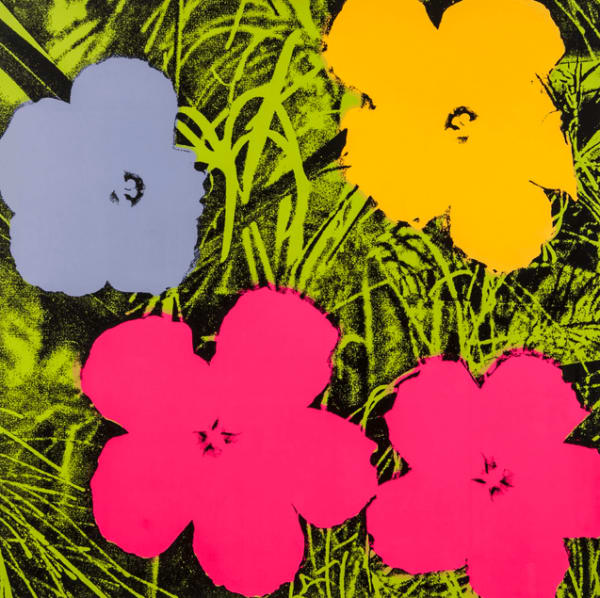While the Flowers today seem emblematic of Warhol iconography, they were at the time of inception a notable departure from images of commercialism (Campbell’s Soup) or celebrity (Marilyn Monroe) for which the artist was becoming known. Fifty years after the publication of the portfolio, the Flowers hold a unique position in the canon of andy warhol prints.
Warhol recalls looking around his studio and seeing only Marilyn, disasters and death so he created the Flowers to contrast his artistic production up to that point. What has now become a classic Warhol image to collectors, started out as being a rebellious image of love and positivity.
Given Warhol’s previous work, his choice to depict flowers initially seems as though it would have been out of character. The project he created previous to this one was a series titled 13 Most Wanted Men, wherein he silkscreened the images of mug shots from the 1962 NYPD booklet. (He created the piece for that year’s New York Art Fair, but the exhibit was censored before it opened.) At this point, one can imagine that the flowers, apolitical and removed from time and space, became an appealing subject.
In 1970 Andy Warhol produced the Flowers , also known as “1970 Flowers”, that were based on the Hibiscus photo, with 10 different color combinations with editions of 250 each . They are screen prints measuring 36 x 36 inches / 91.44 x 91.44 cm and are signed and numbered on the back. Produced from a single source image that was extensively proofed, only 10 prints each with different color combinations were to be editioned. But rather than a direct encounter with nature itself, Warhol used a photograph of hibiscus blossoms he found in the 1964 issue of Modern Photography to create these prints. When Patricia Caulfield, the photographer of this image, found out, she brought suit against Warhol in 1966 for unauthorized use of her image. There is something ironic, almost comical about the fact that Warhol went into a lawsuit for using a simple image of flowers after years of replicating copyrighted product labels– as if in Warhol’s hands, even an unassuming subject could become embroiled in confrontation, politics, and the law.
Their startling colors defied those traditionally seen in nature and their subject matter signaled a departure from Warhol’s commercialism. Here the artist’s interest in still life is explored at length as he continued to crop and silkscreen repetitively, epitomizing the artist’s affinity for repetition. First he took to canvas, then eventually to paper. Until Flowers took root as one of the most iconic series of pop art. Their impulsive color combinations evoke the Flower Power Movement of the 1960s and 70s and serve as a symbol of passive resistance non-violent ideology.
In the Flower prints, several blocks of color comprise the four flowers while a variant of gray outlines the bed of grass. The silkscreen process naturally lends itself to experimentation with respect to color and layering, and Warhol experimented with both, using different color schemes and painting the flowers a vibrant pink and orange in one print and all white in the next. In some of the prints, he deviates from the original template, creating shadows of multiple flowers through several silkscreen prints. Playful and inviting without being overbearing, Flowers was first exhibited in the Leo Castelli gallery in New York in 1964.
Whereas today the Flowers series may seamlessly blend in with Warhol’s oeuvre, the subject matter was - at the time - a sharp departure for an artist known primarily for his images of brands. Flowers themselves are iconic and timeless, untethered to a particular pop culture reference or idea. Indeed, the particular flower in Warhol’s prints is barely identifiable, and critics at the time were unable to name it, which was part of the intrigue.
Warhol has said, “My fascination with letting images repeat and repeat— or in film’s case, “run on”– manifests my belief that we spend much of our lives seeing without observing.” Though an interesting statement from an artist who did not observe directly from nature but from photographs, this series– in all its playfulness, vibrancy, and abstraction– causes us to reconsider the universal appeal of flowers each season.
For more information on Andy Warhol ARt For Sale or to buy Andy Warhol prints, contact info@guyhepner.com. Looking to sell? We can help. Find out how to sell andy warhol art with guy hepner.
January 23, 2024
-
SELECTED FLOWER PAINTINGS AND PRINTS BY ANDY WARHOL









